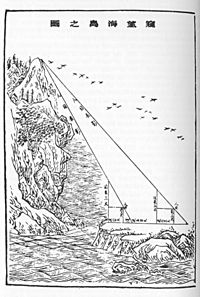Liu Hui facts for kids
Quick facts for kids
Liu Hui
劉徽 |
|
|---|---|
| Born | c. 225 Zibo, Shandong
|
| Died | c. 295 |
| Occupation | Mathematician, writer |
| Liu Hui | |||||||||
|---|---|---|---|---|---|---|---|---|---|
| Traditional Chinese | 劉徽 | ||||||||
|
|||||||||
Liu Hui was a brilliant Chinese mathematician who lived around the 3rd century CE. He wrote an important book in 263 CE. This book was a detailed explanation of an older math book called Jiu Zhang Suan Shu (which means The Nine Chapters on the Mathematical Art).
Liu Hui was related to a noble family from the Eastern Han dynasty. He lived in a state called Cao Wei during a time in China known as the Three Kingdoms period (220-280 CE).
His work on The Nine Chapters on the Mathematical Art included many amazing things. He proved the Pythagorean theorem, which is a famous rule about right-angled triangles. He also made big steps in understanding 3D shapes (solid geometry). Liu Hui even found a more accurate way to figure out the value of π (the number used for circles). He also created a clear way to solve math problems with many unknown numbers.
In another book, Haidao Suanjing (which means The Sea Island Mathematical Manual), he wrote about how to use geometry to measure things like heights and distances. He likely traveled to Luoyang to measure the sun's shadow, which helped him with his calculations.
Contents
Amazing Math Discoveries
Liu Hui was very good at showing math results using a system similar to our modern decimal numbers. He used units of length like chǐ, cùn, fēn, and lí. These units were based on groups of ten, just like our decimal system. For example, he might write 1.355 feet as 1 chǐ, 3 cùn, 5 fēn, and 5 lí. Later mathematicians built on his ideas to create a unified decimal system.
Understanding Triangles
Liu Hui proved a rule that is exactly like the Pythagorean theorem. This theorem helps us understand the relationship between the sides of a right-angled triangle. He gave a long name to his diagram for this theorem. It described how to find a missing side if you knew the others.
Working with 3D Shapes
Liu Hui was one of the best at understanding the volumes of 3D shapes. He figured out how to break down complex shapes into simpler ones. For example, he showed how a wedge shape with a rectangular base could be split into a pyramid and another smaller wedge. He calculated the volume of many shapes like cones, cylinders, and pyramids. However, he couldn't figure out the volume of a sphere. He hoped a future mathematician would solve that puzzle!
Calculating Pi
In his notes on The Nine Chapters on the Mathematical Art, Liu Hui showed a way to get a very good estimate for π. Back then, people often just used 3 for π. But Liu Hui used a method where he drew a polygon (a shape with many straight sides) inside a circle. By making the polygon have more and more sides, he got closer and closer to the circle's actual shape.
He started with a 192-sided polygon and found π was about 157/50. This was similar to how the Greek mathematician Archimedes worked. Liu Hui then used a polygon with 3072 sides! This helped him calculate π to be about 3.14159. This was even more accurate than the numbers found by Archimedes or Ptolemy.
Solving Equations and Negative Numbers
Liu Hui also used a method similar to what we now call Gaussian elimination. This is a powerful way to solve many math equations at once. He also used a method like Cavalieri's principle to find the volume of cylinders. Another mathematician, Zu Chongzhi, later finished some of this work.
Liu Hui's notes often explained why certain math methods worked. He even found some answers that had small errors, which were later fixed by another Chinese mathematician named Li Chunfeng. It's also thought that Liu Hui might have been the first mathematician to discover and use negative numbers. This was even before an ancient Indian mathematician named Brahmagupta started using them.
Surveying the Land
In his book Haidao Suanjing (The Sea Island Mathematical Manual), Liu Hui wrote about many problems related to surveying. Surveying is the skill of measuring distances and heights on land. This book had practical ways to measure things like the height of tall Chinese towers.
He explained how to use "tall surveyor's poles and horizontal bars" to measure things. His book covered many different situations, such as:
- Measuring the height of an island from the sea.
- Finding the height of a tree on a hill.
- Figuring out the size of a city wall from far away.
- Measuring the depth of a ravine.
- Finding the width of a river from a hill.
Liu Hui's ideas about surveying were well-known. A famous mapmaker named Pei Xiu (who lived from 224–271 CE) wrote about how much cartography (map-making), surveying, and math had improved. This included using a grid system on maps for accurate measurements. Liu Hui also wrote about problems related to building canals and river dykes. He calculated how much material, labor, and time would be needed for these projects.
Liu Hui's work was eventually translated into French by a professor named Guo Shuchun. It took him twenty years to complete the translation, starting in 1985!
See also
 In Spanish: Liu Hui para niños
In Spanish: Liu Hui para niños


